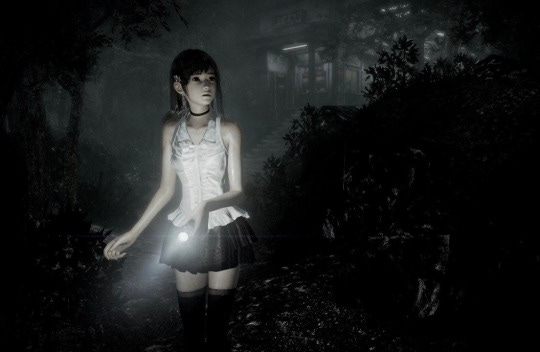If there were such a thing as an upper echelon of girlypop horror, it would have to include the Japanese survival horror video game franchise, Fatal Frame. First released in 2001, Fatal Frame adapts the archetypal ‘Final Girl’ trope to better fit pockets of Japanese culture—particularly through fashion.
It is like I’ve always said: if you’re going to become a horror video game heroine, why not do so in style?
Women in horror have long been characterized under an extensive variety of wide-ranging archetypes (something that I’ve previously touched on), with most of it, historically, through the Western anglophone lens. Fatal Frame is quite unique in the sense that not only is it, on the surface, blatantly Japanese with its culturally rich characteristics, but Japanese in the inconspicuous sense; the quiet subcultural.
Ruffled dresses, skirts, and blouses are what most of the female protagonists in Fatal Frame find themselves in—typically with cuts of lace, dainty bows, and thin stockings—which further reinforces a more youthful, feminine look, characteristic of the otome or maiden style that originated in the late 1970s. Rather than strictly presenting an ‘innocent’ image, the otome culture revolves around ‘a state of mind,’ focusing on the pure and the stoic, along with the fashionably chic and mindful. This, demonstrably, provides a stark contrast to the looming horrors that the game has to offer.
Most of what the heroines seem to wear—in the symbolic color of white—posit a ‘virginal psyche’ in otome that coincides with standard religious affairs. There is an emphasis on ‘purity’ that goes along with traditional Shinto-Buddhist beliefs that, simultaneously, is tied to the concept of ‘femininity’ within the divine. This is relatively pronounced in Shinto, an indigenous Japanese folk religion, which is known for miko, female priestesses who serve as messengers between the spiritual and the mundane and who are, in some ways, culturally similar to nuns.
To a greater extent, the idea of women and their connection to the spiritual plane continue to influence facets of media and pop culture. Fatal Frame makes use of the belief of being or having been ‘spirited away,’ or kamikakushi, a concept popularized with the 2001 Studio Ghibli film of the same name, synthesized along with the ‘Final Girl’ trope. (Chihiro, in my eyes, is also exemplary of a Final Girl.) Kamikakushi, in this instance, is reflective of a social death within the physical; coming out of the spiritual world, on the other hand, is deemed social resurrection—all during a time when women are continuously fighting for social capital, and even a chance at basic respect.
To summarize: Fatal Frame is the it-girl of it-girl horror. You cannot get this much cunt, scare, and cultural awareness with Resident Evil, and much less The Last of Us. Debate me all you want.









